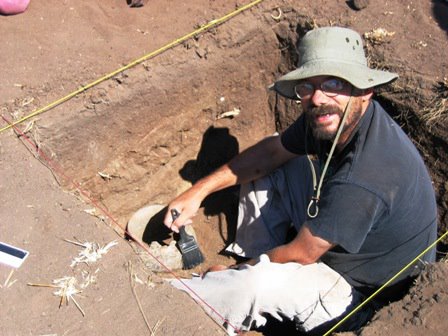 This cute little guy is an Ord’s kangaroo rat (Dipodomys ordii). We caught this little fellow (and several more like him) during the recent Zooarchaeology Conference field trip to northwest Nevada. I particularly like kangaroo rats because they are so docile and will allow you to handle them as long as you’re gentle (pocket mice, on the other hand, are vicious little creatures and will take a nasty chunk out of you if you’re not careful!). You might be wondering why a bunch of archaeologists would be interested in setting trap lines for rodents in the middle of the hot Nevada desert, but it’s rather easy to explain. As archaeologists interested in the use of faunal remains to indicate past human behavior (zooarchaeologists), most of us further recognize the need to go beyond the bones and study animal behavior and distribution as well. Our biologist colleagues always attend the conference and field trip with us and the cross-discipline exchanges have benefitted both sides. [On a side note, I hate to brag, but it was the archaeologist “team” who “out-trapped” the biologist team on this particular trip. However, although we successfully trapped more animals, the species diversity was identical between the teams].
This cute little guy is an Ord’s kangaroo rat (Dipodomys ordii). We caught this little fellow (and several more like him) during the recent Zooarchaeology Conference field trip to northwest Nevada. I particularly like kangaroo rats because they are so docile and will allow you to handle them as long as you’re gentle (pocket mice, on the other hand, are vicious little creatures and will take a nasty chunk out of you if you’re not careful!). You might be wondering why a bunch of archaeologists would be interested in setting trap lines for rodents in the middle of the hot Nevada desert, but it’s rather easy to explain. As archaeologists interested in the use of faunal remains to indicate past human behavior (zooarchaeologists), most of us further recognize the need to go beyond the bones and study animal behavior and distribution as well. Our biologist colleagues always attend the conference and field trip with us and the cross-discipline exchanges have benefitted both sides. [On a side note, I hate to brag, but it was the archaeologist “team” who “out-trapped” the biologist team on this particular trip. However, although we successfully trapped more animals, the species diversity was identical between the teams].It’s one thing to just identify the bones to species or genus level; but understanding the animal’s behavior is crucial to understanding its relationship to past human societies: as prey, as an indicator of environment, as an exchange item, as a source of raw material, etc. All aspects of animal behavior affect the technology, organization and resource acquisition behavior of humans. It is not sufficient to simply indicate that you have bighorn sheep or zebra in the faunal remains from your site. Those remains also imply particular things about human prey selection, transport, hunting method, economic return,
 seasonality, abundance and distribution. Understanding the behavior of a species is just as important as being able to identify its left distal tibia.
seasonality, abundance and distribution. Understanding the behavior of a species is just as important as being able to identify its left distal tibia.Of course, apart from providing a context for interpreting zooarchaeological remains, viewing and learning about wildlife is fun in and of itself. On our trip through northeastern California and northwestern Nevada we also encountered pronghorn antelope and mule deer, and in the High Rock Canyon in Nevada we were fortunate to come across this group of bighorn sheep. It was a magnificent sight as these animals are generally elusive. Besides the larger game animals and rodents, we also encountered a huge variety of bird species as well. My wife and I have found the fun in bird watching and have started our own list of identified species. It's a bit short now, but that will certainly change in time.




No comments:
Post a Comment